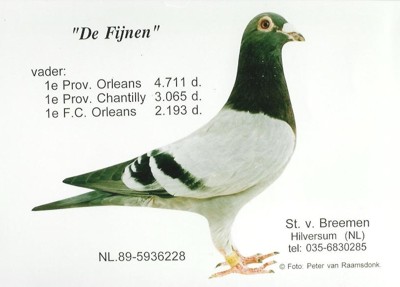
What exactly is the meaning of inbreeding??

With inbreeding we are compiling genes, good ones as well as bad ones, from those special pigeons we are concentrating on in our breeding program. The chances of getting youngsters with identical genes increases as we step up the rate of inbreeding. The trouble is that on the one hand as we concentrate, we will at the same time lose ground in the areas of vitality and the ability to come into shape.

"De Fijnen" is heavily inbred on the lines of the golden Janssen foundation hen "De 08 Duif". After a successful racing carreer he bred many outstanding birds like "Magic Orleans" a cock to win within 1 year 3 provincial races and the nr. 1 hen of Mr. Willem de Bruijn of Reeuwijk mother of the 1th National Ace Young 1997.
Sure you may find an inbred pigeon with plenty of vitality. In a case as this it's safe to say that this pigeon has a geno-type not as concentrated as you hoped it would be. Still, it may win you many prizes. Concerning its offspring however, you may find that it won't pass on to them what could have been expected, judging by the pedigree.
Now you have done the inbreeding the right way and you end up with a degenerative looking bird, who lacks vitality and doesn't seem to get itself into shape well. There's not much hope for such a pigeon to fall into the prizes. But it is quite well possible that the off-spring will win big when she is cross-bred with the right bird.
That's where most fanciers go wrong. They get rid of what they consider to be the less successful results of inbreeding and they keep the liveliest ones. The idea behind inbreeding is concentrating of special genes. Those fanciers select incorrectly and keep the birds with very few of those special genes they are supposed to transmit to the next generation. Remember, a piling up of genes goes together with a loss in vitality!
What would be the right system for inbreeding? I once read in an article by the late John Lambrechts that a system of remote inbreeding was the only way to do it. I do not agree with this. At one time I had in my flock the best lines from the continuously bred stock of Desmet-Matthijs, and De Baere Brothers. Before I started to breed with them I first made sure that these lines were suitable for crossing. After that I drew up a plan how best to pair them. I used to have excellent results with this type of remote inbreeding. In the generation which followed however, I noticed that slowly, but surely, I was loosing in the quality of the breeding material, and in the quantity of good fliers. When I became aware of this my next question was: where do I go from here??
In 1974, I stayed at the home of Professor Alfons Anker for quite some time. After the lectures he gave me on his life time work: population genetics, I became obsessed with the subject. Together with him I have explored all that which can be applied to breeding. Since I was convinced by then that it is possible to breed good fliers as well as good breeders, following a set schedule, we proceeded putting together a theoretical concept and drew up plans for pairing. I have been breeding according to that schedule ever since and hardly ever have I strayed away from it.
In those years Prof. Anker had come to the conclusion that as far as he was concerned there was no better breeder than "Klaren 46". Our schedule was set up using him as a guideline. "Klaren 46" paired with different hens would transmit very well and his children proved to be able to do the same. In those same years I was the owner of several "Klaren 46" grandchildren and I tried the utmost to find as many of them as possible into my breeding schedule for the purpose of keeping a large variety in my flock. Which grandchildren did I select?
Table one the percentage of "Klaren 46" genes:
Pair: Klaren 46 paired with Hen X
Gives children: 50% Klaren 46 and 50% "X"
Grandchildren:
a. Races and breeds reasonable: 10-15%
b. Races and breeds well: 25%
c. Races and breeds super: 30-50%
I would advise you to memorize Table 1. It shows clearly the reduction you get when the chromosomes are divided.
Naturally, the grandchildren under "C" are the most suitable birds to continue breeding with. They evidently show most of the signs of their value and inherited the largest percentage of "Klaren 46"-genes.
Table Two the mating schedule of "Klaren 46" grandchildren.
Parents: 5 grandchildren of "Klaren 46": A,B,C,D and E.
Matings: A x B and C x D. Grandchild E is not used yet.
1st Generation pair A x B: children nrs 1,2,3 and 4.
1st Generation pair C x D: children nrs 5,6,7 and 8.
Then a combination of the children of both the pairings from the pairs A x B and C x D:
2nd Generation mating:
a. 1x5 give the youngsters: 9 and 10.
b. 2x6 give the youngsters: 11 and 12.
c. 3x7 give the youngsters: 13 and 14.
d. 4x8 give the youngsters: 15 and 16.
3rd Generation mating:
9 x grandchild E.
My breeding schedule above starts with 5 grandchildren, who all had "Klaren 46" as the ONLY common ancestor. The second generation was paired with an A,B,C,D or, what might even been better, with the remaining grandchild E.
The inbreeding with "Klaren 46" is completed with the third generation.
As you can see, quite a bit of inbreeding. This is even more so since the Desmet-Matthijs flock itself has also been inbred. What about the dreaded degeneration problem? When working according to such a concentrated schedule of inbreeding, as I did for several years, you logically would expect to notice signs of degeneration. But so far so good. As a matter of fact, the opposite seems to be true: the eyes improved in color and have more pigmentation, with pupils as small as pin-heads. There was no noticeable change in the muscle quality while the build stayed the same as well: the cocks being on the big side and the hens quite fine. I observed no external signs of degeneration at all. The offspring became much better, as breeding stock, as we concentrated more on "Klaren 46". It was also very nice to notice that the pigeons at the same time performed well.
However I'm not about to tell you that my experience is the only gospel. It is important, when practicing inbreeding to keep a close eye on the following:
1. With inbreeding some characteristics, such as vitality, endurance and getting into form, slowly deteriorate. The reason for this is that only a few genes are involved in transmitting these characteristics and therefore they are the first ones to backslide. It is possible to counteract this by cross-breeding with the right bird after inbreeding. You may get some very positive results with this.
2. There are other very important characteristics which are indispensable in the pigeon sport and they also positively are influenced by inbreeding. Cross-breeding however, doesn't improve them. Again, these characteristics are determined by hundreds of genes and they all are transmitted intermediary, which means that the end product is half of the sum of what both parents contribute, no matter if we practice inbreeding or cross-breeding. It becomes quite evident then that the only road to take is the one involving rigorous selection together with a well planned breeding schedule.
Let us not forget the primary reasons for inbreeding! In the first place we're after valuable genes of an extra-ordinary pigeon. Secondly, we try to collect a high concentration of a certain pedigree. When we concentrate in our breeding schedule on a special pigeon, and as the concentration rises, we may expect that the results will be as follows:
1. Many more pigeons in this pedigree will be carrying genes from the special bird on which we concentrated our schedule.
2. The transmitting power of the birds obtained from this breeding program increases in value if the common ancestor was indeed very special.
3. These pigeons will slowly loose in appearance. At the same time they will become less successful racers, even more so on long and difficult races which puts an extra burden on their bodies.
Conclusion: while they loose in body strength, they gain as breeders. Inbred pigeons are best suited as breeders(the first generation can be cross-bred very successfully) but they are not very successful as racers, especially not in the category of hard day & long distance races. This appears to be a general rule. Now what?
Steven van Breemen
Copyright 1998. All rights reserved. Reproduction in whole, in part, in any form or medium, without the express written permission of Steven van Breemen, is forbidden.
The whole book can be downloaded from "Winning Magazine" if you are a subscriber. You can subscribe here; costs 35 Euro for 1 year. You get 26 issues and have access to the archives with all previous published issues plus next to "The Art of Breeding" a second book written by me: "Hints for Mating, Breeding & Selection". A total bargain!